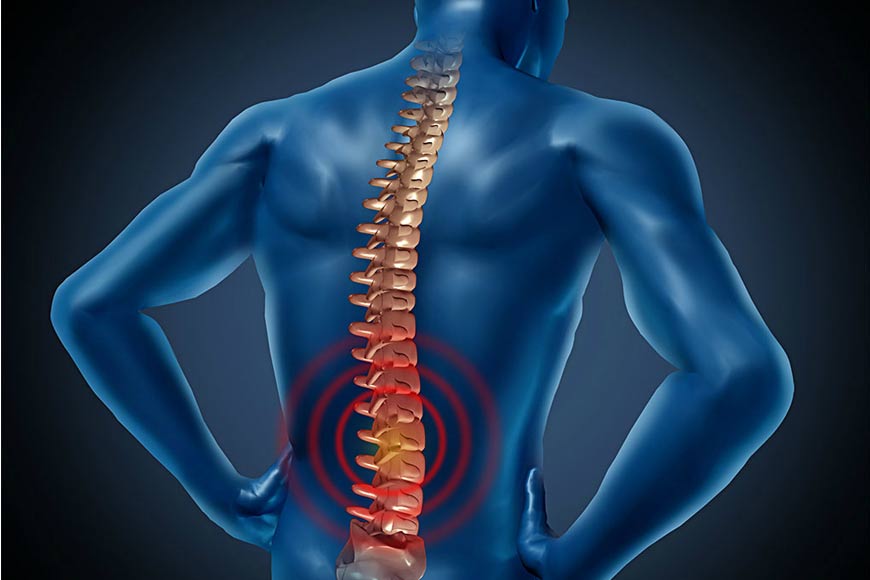Working Time
- Mon-Thu 08:00 - 20:00
Friday 07:00 - 22:00
Saturday 08:00 - 18:00
Contact Info
-
Phone: 011 240 40 46
011 407 82 31
064 258 89 85 - info@ffb.rs
Ask the Experts
Physical Therapy of the back

Back pain
There is almost no person who has not suffered from back pain at least once in his life. The causes of back pain can be different, but statistics show that the most common problem is the "popping out" of the intervertebral disc.
Disc herniation, as this medical problem is called, is a very common disease. The pain caused by a herniated disc is no different from "ordinary" back pain, so it is essential that you contact us as soon as possible in order to receive the correct diagnosis.
A herniated disc is a disease of the spinal column that occurs due to an altered condition of the disc - a small intervertebral "cushion". The altered condition and function of the disc occurs due to degenerative changes, and disc herniation often occurs as a result of an injury.
When one or more discs are displaced from their intervertebral space, they press on the surrounding nerves and symptoms occur. Those who suffer from this disease most often complain of severe pain in the leg or arm.
Displacement of discs usually occurs in the lower, lumbar part of the back, in 70 to 80 percent of sufferers. However, neither the cervical nor the thoracic part of the spine is protected from disc herniation. It is not excluded that a disc herniation is localized in all three parts of the spinal column in any patient, which is a rare condition.Disc herniation mostly affects people in the most productive age of life, between 35 and 45 years old, both men and women.
In the initial stage of disc herniation, pain usually occurs in the affected segment of the spine, which most patients ignore. With the help of analgesics, the pain is removed or alleviated, but this is not a sign that the problem has been solved. Most suffer from this unpleasant condition until it becomes difficult to move. That is why timely diagnosis of disc herniation is very important. It is carried out with the help of magnetic resonance, which records the endangered part of the spinal column. Magnetic resonance is the only necessary diagnostic method, because it gives a clear picture of the extent of changes and damage to one or more discs.
Causes
Prolonged sitting, insufficient physical activity, excessive recreation, improper lifting of loads, as well as genetics are among the causes that lead to disc herniation.
Symptoms
The most common symptom of a herniated disc is back pain that can radiate down the leg. Most patients describe the pain due to a herniated disc as "walking", which goes from the back to the knees, and can also go down to the feet. When sitting, standing or walking for a long time, the pain usually increases. It is not uncommon for patients to describe the pain as stabbing, especially after rotating the spine or after sneezing or coughing.
Back pain treatment
Examinations of patients who have problems with disc herniation in our practice are performed by Dr. Radoje Čobeljić, a specialist in physical medicine and rehabilitation, who has three decades of work experience in the Rehabilitation Clinic.
When the pain is removed and the inflammation is healed, we start kinesitherapy with the patient, that is, we prescribe certain exercises. Exercises should be done three to four times a week, but under the professional supervision of a physiotherapist.
Every patient who comes to our office can expect that the exact cause of their pain will be determined during the examination. Timely examination and adequate application of appropriate physical therapy are the keys to success in the treatment of disc herniation.
By applying methods from physical medicine, disc herniation is effectively repaired. Physical therapy affects the successful relaxation of the muscles around the spinal column, which are often cramped and shortened due to disc herniation. Muscle relaxation relieves pain and chronic tension.
The safest and most effective method of disc herniation treatment is physical therapy with spinal decompression, which aims to act on the cause of the pain itself. After spinal decompression, there is a micron movement of the vertebra and the disc returns to its place. This releases the pinched nerve and relieves the pain.
Free Viber consultations with a specialist doctor
For a free consultation with a specialist doctor, please call us or send a Viber message to the following number: 064 258 89 85.






